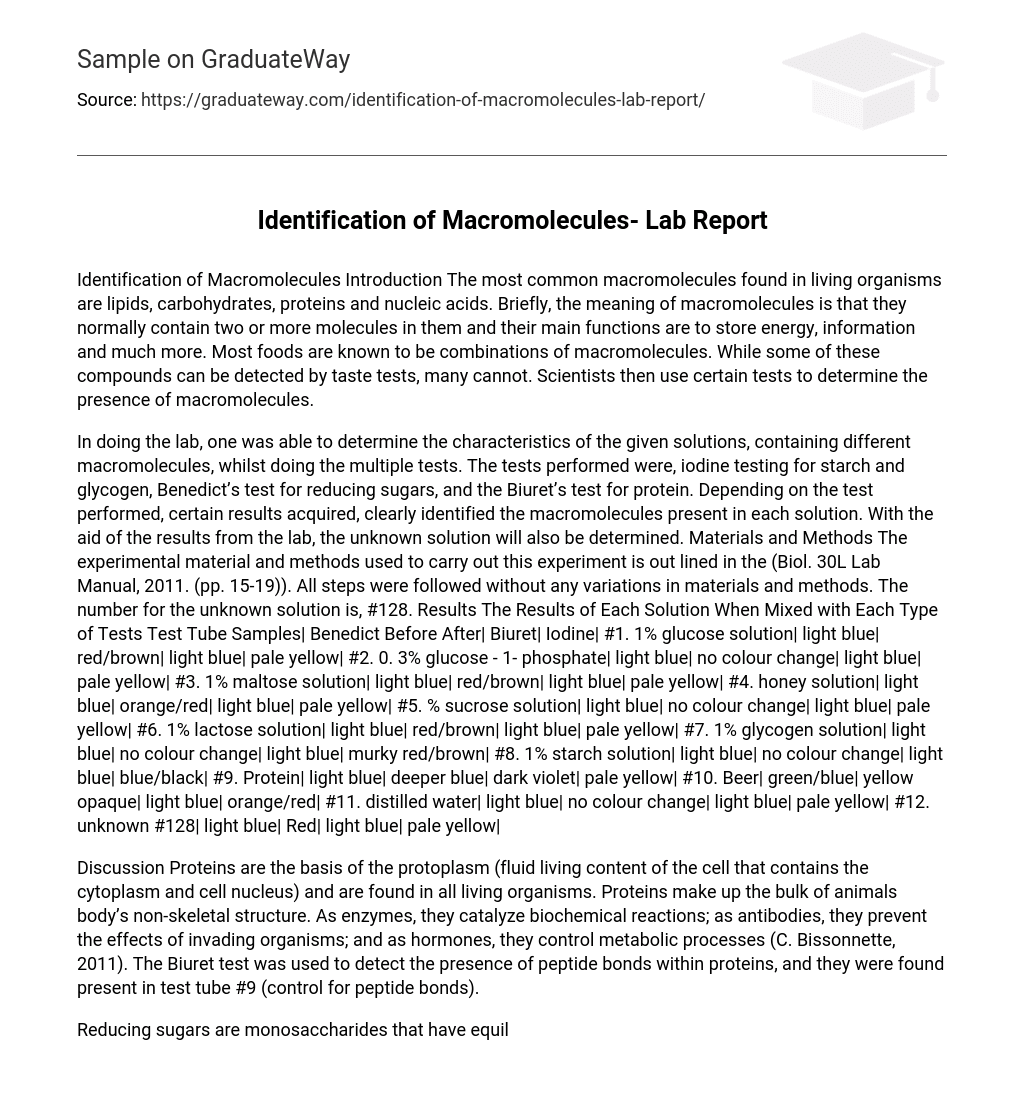Introduction
The most common macromolecules found in living organisms are lipids, carbohydrates, proteins and nucleic acids. Briefly, the meaning of macromolecules is that they normally contain two or more molecules in them and their main functions are to store energy, information and much more. Most foods are known to be combinations of macromolecules. While some of these compounds can be detected by taste tests, many cannot. Scientists then use certain tests to determine the presence of macromolecules.
In doing the lab, one was able to determine the characteristics of the given solutions, containing different macromolecules, whilst doing the multiple tests. The tests performed were, iodine testing for starch and glycogen, Benedict’s test for reducing sugars, and the Biuret’s test for protein. Depending on the test performed, certain results acquired, clearly identified the macromolecules present in each solution. With the aid of the results from the lab, the unknown solution will also be determined.
Materials and Methods
The experimental material and methods used to carry out this experiment is out lined in the (Biol. 30L Lab Manual, 2011. (pp. 15-19)). that contains the cytoplasm and cell nucleus) and are found in all living organisms. Proteins make up the bulk of animals body’s non-skeletal structure. As enzymes, they catalyze biochemical reactions; as antibodies, they prevent the effects of invading organisms; and as hormones, they control metabolic processes (C. Bissonnette, 2011). The Biuret test was used to detect the presence of peptide bonds within proteins, and they were found present in test tube #9 (control for peptide bonds).
Reducing sugars are monosaccharides that have equilibrium with the straight-chain and cyclic form, which the sugar engages in an oxidation-reduction reaction with Cu2+ (C. Bissonnette, 2011). Through this test, one is able to determine that the unknown solution #128 is a non-reducing sugar because the results show that the test turned out positive, and reducing sugars cause negative tests to occur. The iodine test is used to identify glycogen and starch. These polysaccharides combine with iodine to form either a blue/black colour (for the presence of starch) or a red/brown colour (for the presence of glycogen) (ChemBook, 2003).
Polysaccharides are a formation of monosaccharide’s linked together. The simplest polysaccharides contain two sugars and are given the name disaccharides. Starch is a storage polysaccharide in plants where as glycogen is a highly branched storage polysaccharide in animals. Both play a part in providing energy.
The glucose produced in plants are stored in the form of starch and then released when energy is needed. Glycogen is stored in the liver and muscles of animals, and is released when energy is needed with the help of enzymes breaking down the glycogen (J. Sharp, 2011). Starch was present in test tube #8 (control for starch) and glycogen was present in test tube #7 (control for glycogen).
The results that one obtains from this experiment closely match the results of other groups when compared during lab. This experiment gave an understanding of the different types of colour change reaction that occurred when each solution reacted with the testing solutions. Also, with the aid of the results from the sample solutions, one is able to compare and determine what the unknown solution was as well.
References
- C. Bissonette, F. G. Herring, J. D. Madura, and R. H. Petrucci, General Chemistry (Principles and Modern Applications), Prentice Hall, Tenth Edition, 2011.
- Department of Biology 2011 Introductory Cell Biology Laboratory Manual. University of Waterloo, Waterloo. Pp 15-19
- J. Sharp, M. Harrington, and S. Freeman, Biological Science (Introductory Cell Biology), University of Waterloo, Canadian Edition, 2011.
- Starch – Iodine (2003). Virtual ChemBook. Retrieved September 23, 2011, from http://www. elmhurst. edu/~chm/vchembook/548starchiodine. html





